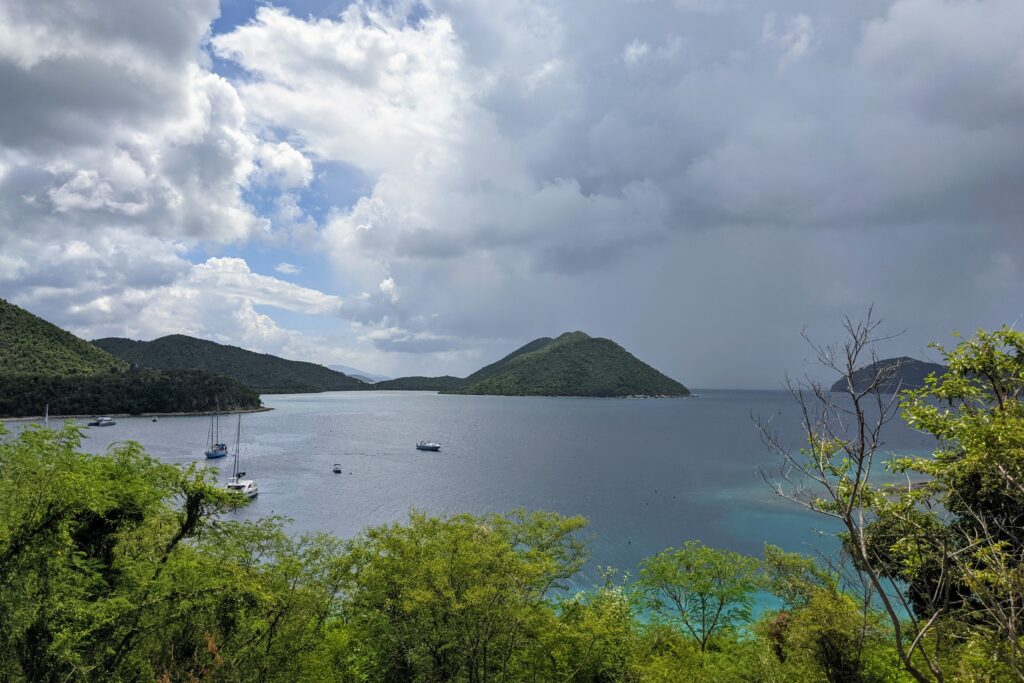
One of my favorite pieces of advice I’ve received during my internship so far is to “maintain a rigid state of flexibility.” The cleverly paradoxical phrase, told to me by Brian Lariviere, serves as a reminder to wholeheartedly embrace a mindset centered around adaptability. It was a particularly useful piece of advice for the last two weeks, as I made an unexpected return to the U.S. Virgin Islands (USVI). This time, instead of flying to St. Croix, I ventured to St. John — home of Virgin Islands National Park.
I was immediately intrigued by the USVI when I visited St. Croix for my first internship project — reef surveys for the National Coral Reef Monitoring Program (NCRMP). Nostalgia hit me as soon as I landed, and I found myself reminiscing about my island days on Koh Tao. I missed the slowness of island time. I missed palm trees. That feeling of constantly being sticky from humidity? Surprisingly enough, I missed that, too. The two weeks on St. Croix passed quickly, though, and I didn’t have a chance to explore the other U.S. islands — St. John and St. Thomas. When I left at the end of June, I didn’t know when I would return. Soon, I hoped, but it wasn’t initially in the cards for the remainder of my internship.
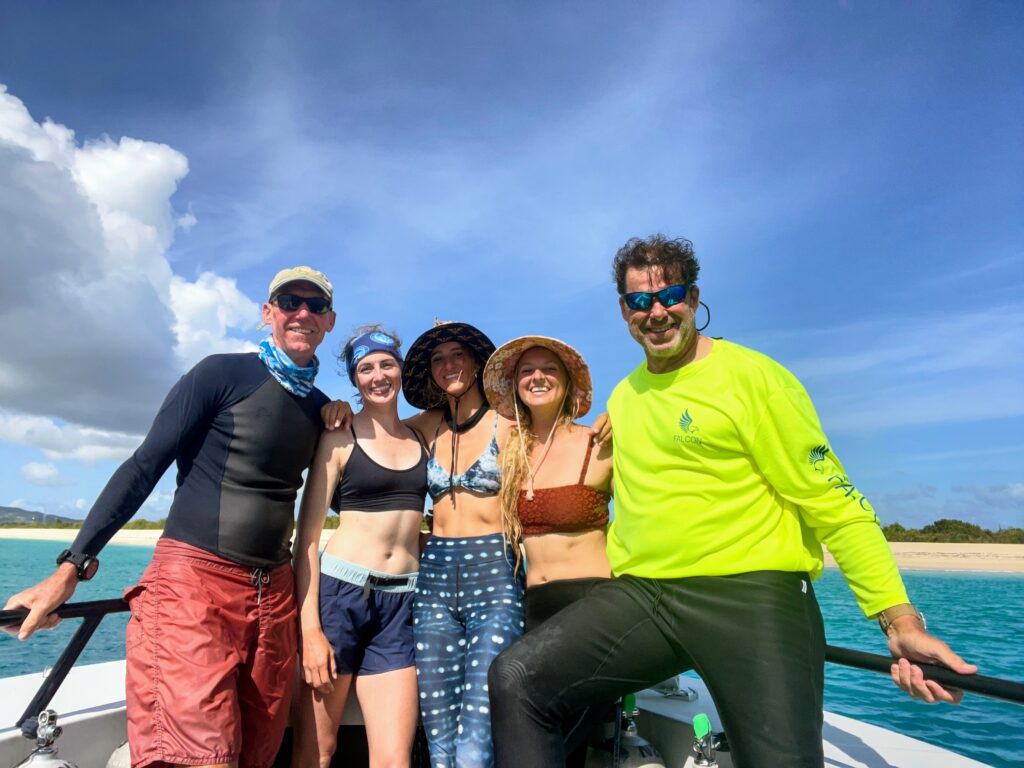
The St. Croix NCRMP crew (from left): Jeff Miller, me, Kaya Carrión, Kristen Ewen, and Mike Feeley
The opportunity to return to the cluster of Caribbean islands arose when I was working with the NPS South Florida Caribbean Network (SFCN) crew during a recent project in Dry Tortugas National Park (DRTO). Coral biologist Jeff Miller and marine biotechnician Lee Richter mentioned a need for more divers to complete NCRMP surveys around St. John and I was already trained and eager to return to the USVI. It didn’t take long until I was testing my “rigid state of flexibility” by rebooking flights, changing car and Airbnb reservations, and preparing to leave DRTO a little earlier than expected.
A few days later, I departed DRTO on the MV Fort Jefferson with the SFCN crew — Jeff, Lee, marine biologist Rob Waara, and intern Brandy Arnette. After the five-hour cruise back to Key West, we quickly shifted into scramble mode. The SFCN crew was trying not to exceed a 10-hour workday, but they’d already lost half of that to the ship journey alone. We still needed to unload gear and transfer it to our two vehicles, pull the SFCN boat out of the water (it had been towed by Fort Jeff), load it onto the trailer, and then drive up to Miami to store the boat. It was going to be a long day no matter what. To make matters more eventful, a torrential thunderstorm rolled through as we were transferring gear from the ship to the cars, leaving all of us soaked to the bone by the time we started the four-hour drive to Miami. I rode along with Lee and Rob in the truck pulling the SFCN boat. Traffic was surprisingly clear up the Keys and we were having a grand ol’ time, rapping to 90s hip hop and reflecting on the last week in DRTO. We were making good time — that is until Rob glanced at the boat trailer in the rearview mirror and announced, “looks like we’ve got a flat.”
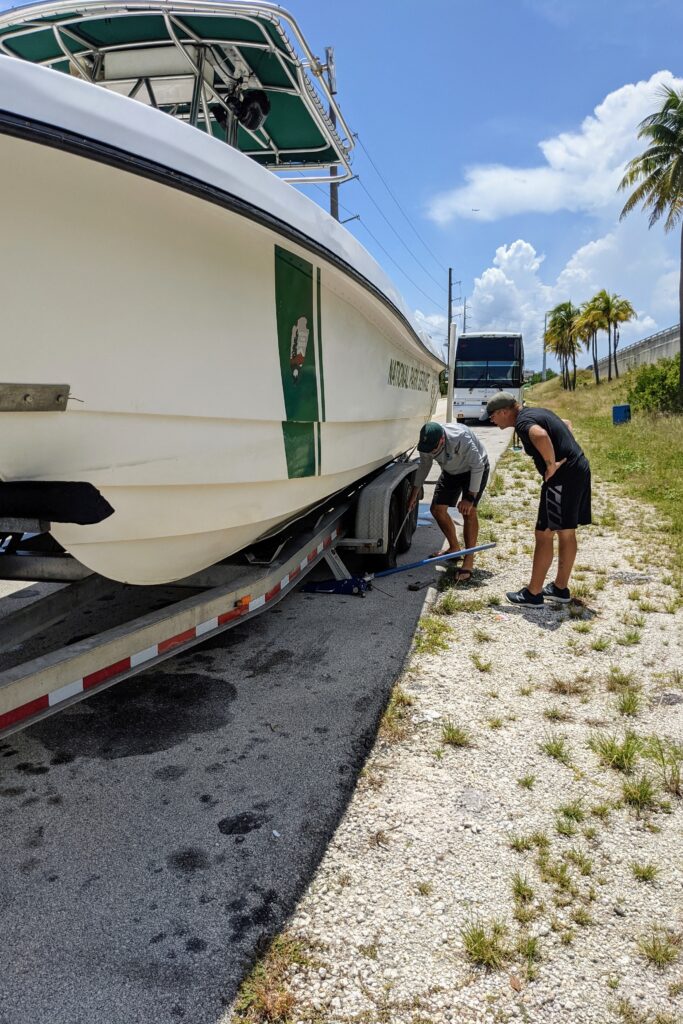
Lee (left) and Rob (right) assess the damage.
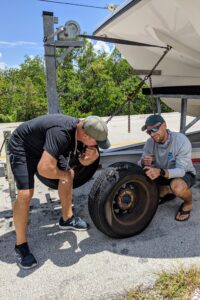
“What could possibly be wrong?”
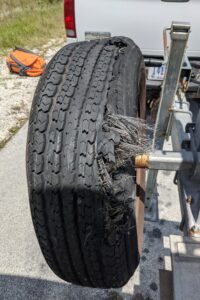
I associate the word “shredding” with surfing, sensitive documents, and skateboarding — preferably not tires.
Fixing a flat tire on a loaded boat trailer is no joke. Two jacks, both raised to their max, provided barely enough lift to remove the shredded tire and replace it with the spare. Still wet from the rainstorm and now covered in dirt and grease, I think it’s safe to say that all three of us were pretty done with the day at that point. Despite our fatigue, with some coffee, snacks, and more 90s hip hop, we were able to finish the day in relatively good spirits (and without any further mishaps) and make it back to our respective homes for the night.

A day and a half later I found myself staring out a plane window, taking in the views of St. Thomas. Steep, rugged hills ran east to west across the island and colorful houses stood scattered throughout the hillside. The bright orange-red flowers of flamboyant trees provided further contrast against the island’s bright green foliage. Paired with the warm sunshine, turquoise waters, and pervasive humidity, it was a true slice of Caribbean paradise. I spent a bit of time on the island to catch up with friends, but my final destination was six miles across the water on the neighboring island of St. John.
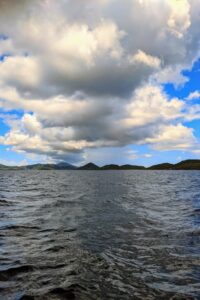
St. John’s white-sand beaches and warm blue waters caught the public eye in the 1930s, causing the tourist industry to take off on the sleepy paradisial island. By the 1960s, Virgin Islands National Park had been established, encompassing 60% of St. John and nine square miles of offshore waters. Virgin Islands Coral Reef National Monument protects an additional 20 square miles of open water and coral reefs around the island. Above water and below, Virgin Islands NP is a tropical wonderland, absolutely teeming with natural beauty and cultural history.
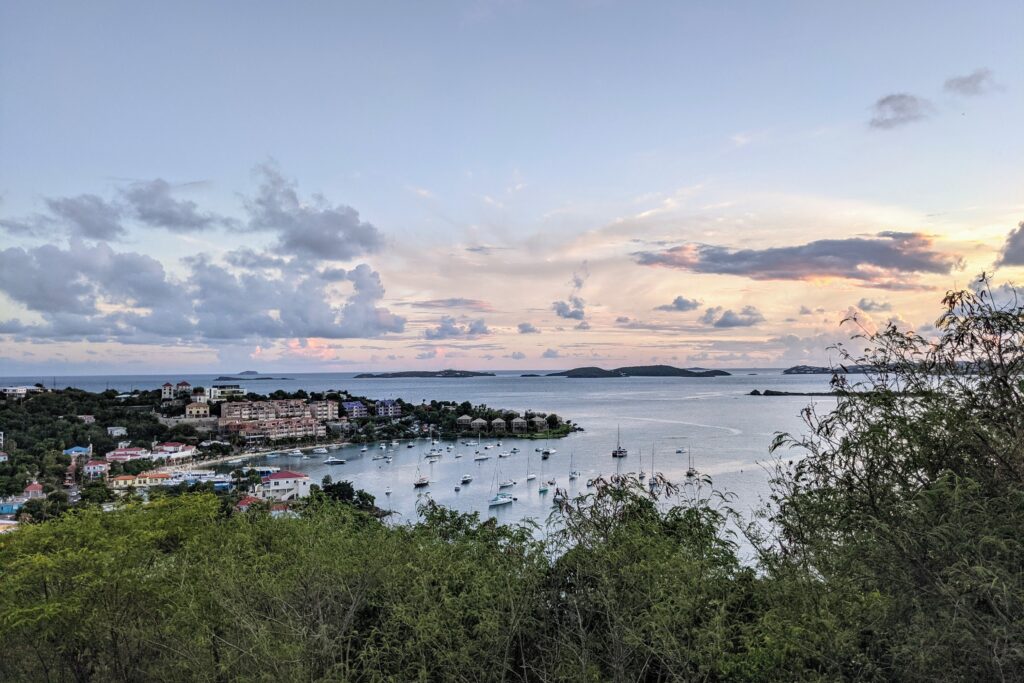
The house I stayed in had a fantastic view of the main harbor in Cruz Bay.
Wonderland turned to wasteland on September 6th, 2017 — the first day of Hurricane Irma’s violent ravage directly through the USVI. For six days, Irma’s raging Category 5 winds and torrential rains ripped roofs from buildings, sunk boats, and washed away roads. After six days of Irma’s destructive spree, St. John’s landscape was not only in ruins, it was denuded of greenery. If a tree miraculously still stood, the leaves had blown away, altering the overall hue of the island from a lush green to a flat brown. Whatever remained was further battered by Hurricane Maria, another Category 5 storm that roared through only a week later.
The damage was unquantifiable. People, infrastructure, forests, mangroves, coral reefs — everything suffered from the twin hurricanes’ devastating blows. Within the national park alone, 25 NPS facilities were markedly damaged or destroyed, including employee housing. Sections of shoreline around the island were significantly eroded. 90 vessels sunk or washed aground within the park’s waters and the coral reefs were smothered by loose sediment and debris. Additionally, the brute force of the hurricanes dislodged entire coral colonies — some of which weigh hundreds, if not thousands of pounds — and ripped apart corals that were hundreds of years old, killing them overnight.
The national park’s reefs were in the very early stages of hurricane recovery when Stony Coral Tissue Loss Disease (SCTLD) was first spotted within park boundaries in 2019. SCTLD is a rapid, lethal waterborne disease known to infect at least 20 scleractinian (i.e. hard) coral species. It’s exactly what you don’t want to show up when a coral reef has only just started to stabilize after a devastating natural disaster. The resulting compounding damage has severely stressed the national park’s reefs over the last few years.
Monitoring and surveying efforts are essential to understanding how Virgin Islands NP’s valuable reef ecosystems are responding in the wake of such severe stressors. For two weeks, I set out with Jeff, Lee, Natural Resources Manager Thomas Kelley, and Park Dive Officer Devon Tyson to conduct NCRMP surveys around St. John. NCRMP was established in order to collect data on reef composition, fish biodiversity, and coral cover. In the USVI, it’s a collaborative effort between NPS, NOAA, and the University of the Virgin Islands (UVI). The data collected from NCRMP provide collaborators with a comprehensive picture of Caribbean reef condition and are used to inform policymakers and researchers.
Procedurally, the surveys were identical to what I did in St. Croix back in June. Not only that, we were working off of the same boat, Eddie Boy, and it was my third time working with Jeff and Lee. I still had lots to learn about the park and plenty to explore, but it was nice to be familiar with the workflow and some parts of my new environment. Plus, I always learned a lot and had a great time with the SFCN crew.
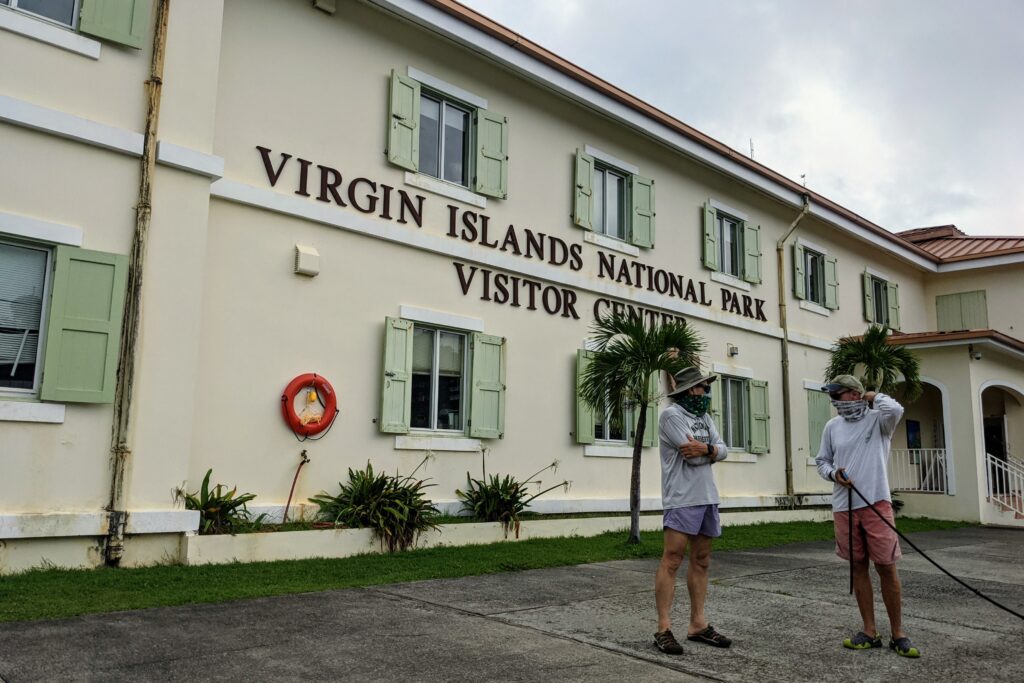
Within a few hours of arriving at the park, we were out on the water and back to the NCRMP grind. Like the St. Croix surveys, our assigned sites were randomly selected GPS points based off of benthic maps. There was supposed to be hard bottom (suitable foundation for coral) at each site, but occasionally we’d dive down and see fields of seagrass or barren patches of sand. In that case, we’d head back up, climb onto the boat, and take off to the next site. Those dives aside, we managed to drop onto some super interesting patches of reef. We went all over — from shallow (sometimes too shallow) sites in protected bays to 90 ft. sites on the mid-shelf reef. This was an exciting aspect of NCRMP dives — you never knew what you were going to survey.

A view of the busy St. John marina as we ventured out for the day.
We covered quite a bit of ground (or should I say water?) doing NCRMP surveys. We saw St. John from practically every angle. As we boated from site to site, long-time St. John residents Thomas and Jeff regaled me with facts and stories about the island’s history, the establishment of the park, and some of the ongoing park issues, like removing large pieces of debris and boats that sank during hurricanes Irma and Maria. The conversations were eye-opening but short-lived, because before we knew it, we were at another survey site. We geared up, rolled off the boat (Jeff did an occasional flip), and descended underwater once again. The surveys were fast and intense. I was doing fish assessments, which entailed recording all observed fish species, their quantity, and their sizes. Once I finished recording fish data, I also recorded data about the benthic habitat, like the percentage of coral cover and whether or not any coral disease was present. Since SCTLD hit this area of the USVI a while ago, a lot of coral colonies were in the later stages of the disease or had already been killed. But, long-term monitoring efforts like NCRMP help track further spread of SCTLD and inform researchers about which reef sections around the island are most heavily affected.
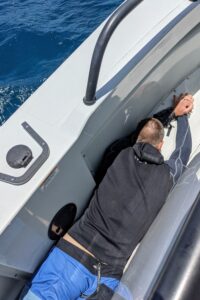
Long days on the boat meant finding creative ways to sneak in a power nap. I preferred laying on the pile of warm aluminum tanks at the bow of the boat, but Lee opted for this comfortable (?) spot.

An important balance: filling out data sheets and fulfilling caloric needs.
The weather was splendid for the majority of our dive days, but it was the middle of hurricane season, so a storm here and there was to be expected. One night, I tossed and turned in bed while I listened to the wind howl and rain hammer on the roof as a small tropical storm came through. By the morning, the weather hadn’t totally cleared up, but the team was determined to try to survey a few sites — weather permitting. Jeff and Devon selected survey sites that were relatively close to the marina and we headed out on the choppy waters. We had just arrived at the first site when the rain and winds picked up and surface visibility became a concern. Our best bet was to wait it out for a bit and see if the conditions resolved. We checked the weather radars and snacked until the weather cleared up enough for divers to jump in.

A stormy day on St. John.
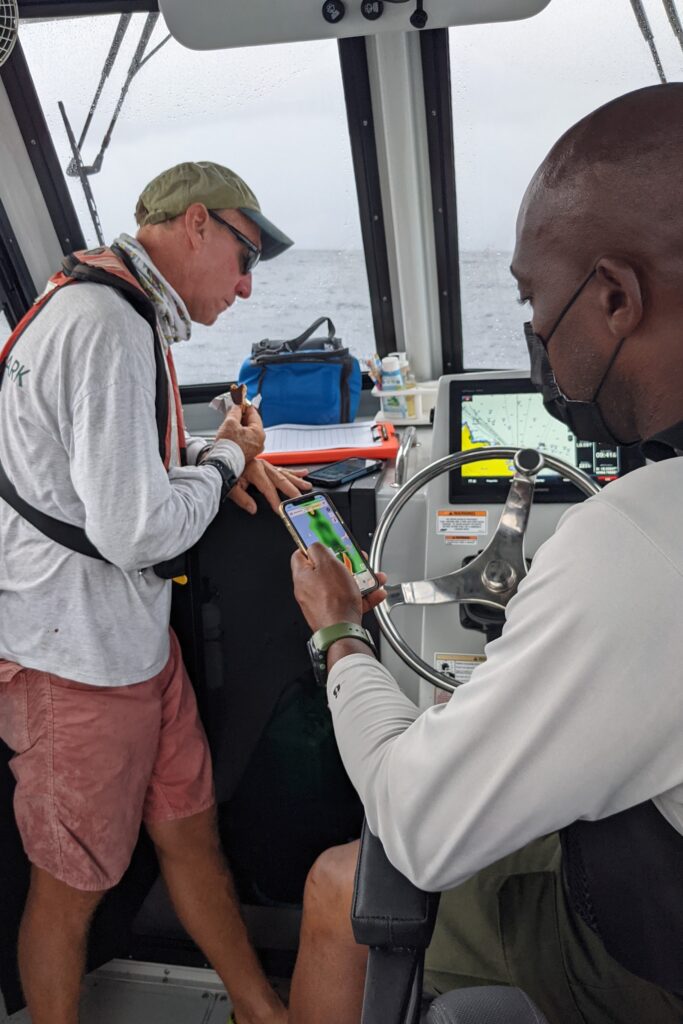
During the storm, Jeff (left) and Devon (right) kept an eye on the weather radar while we waited it out on the boat.
NCRMP dive days kept everyone busy. Devon, our boat captain, was always plugging site coordinates into the boat GPS, navigating to the next site, or keeping an eye out for surfacing divers while surveys were underway. For us divers, having a small crew meant that oftentimes all four of us were needed for each dive. If we went to a site that only needed one of the two assessments done (benthic or fish), two people would stay topside and provide support to the divers doing the survey by helping them with their gear and handing them the necessary equipment before they jumped in. A short 20-30 minutes later, the divers would surface and we would boat over to them, help pull their gear onto the boat, and get their take on the site condition and anything interesting they saw. Even if a site was algae-covered and generally non-exciting, Jeff, Lee, and Thomas would jokingly marvel at the end of the dive. “That’s some fantastic pavement down there,” Jeff sarcastically enthused. “Just incredible.” “Pavement” was the term for flat rocky hardbottom, often with a thin layer of sand and sparse coral coverage. Not the most thrilling, but still important to survey!

A brief detour on the boat ride back to the marina — one of the park’s channel marker buoys broke free and washed ashore on one of the beaches. We carefully boated close to shore and Jeff retrieved the stranded buoy.
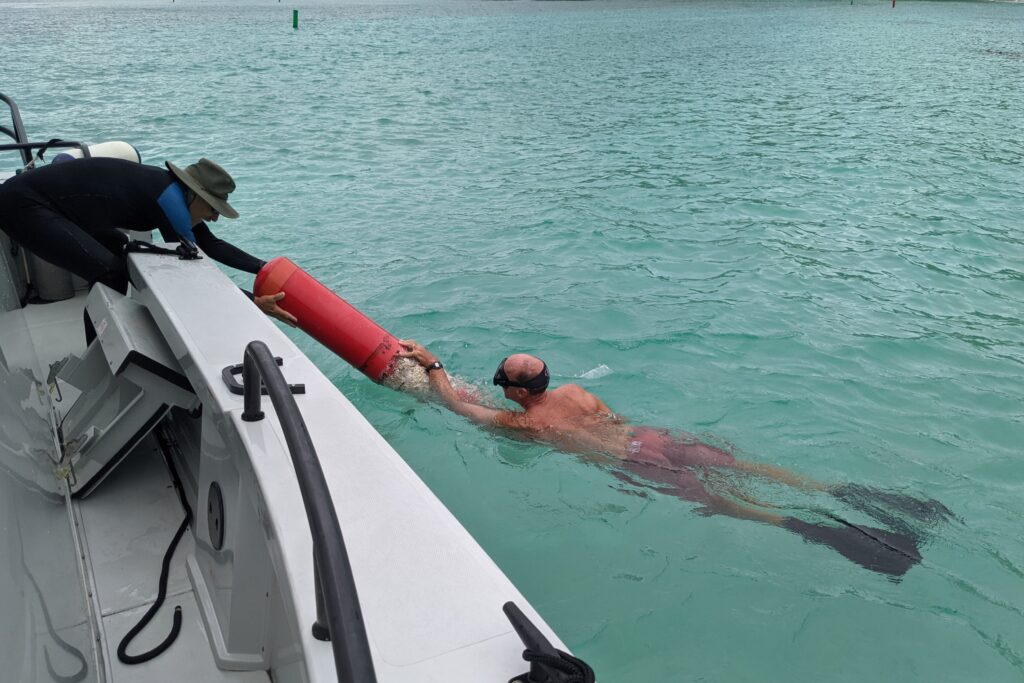
Thomas (left) and Jeff (right) get the rogue buoy onto the boat.
In addition to monitoring projects such as NCRMP, NPS biologists are hoping to pursue more direct mitigation efforts in order to preserve and rescue select coral species that are threatened and/or highly susceptible to SCTLD. Last year, a proposal was submitted to collect samples of target coral species (ones known to be endangered and susceptible to SCTLD) within five NPS boundaries in the South Florida/Caribbean region. Once collected, the samples would be analyzed for their genotype (i.e. their unique genetic makeup). Having this data would open many doors for coral rescue and conservation efforts and provide insight into which coral species are more or less resilient to disease and other environmental stressors.
Just last month, samples of pillar coral (Dendrogyra cylindrus) were taken from colonies in DRTO to be genotyped and preserved at a Florida museum. Pillar coral is a rare species that is currently listed as “threatened” under the Endangered Species Act. It is quite susceptible to SCTLD and has nearly been wiped out from Florida’s coral reefs. During all of my dives around St. John, I only encountered the species once. I remember Thomas enthusiastically beckoning me over to the small pinkish-tan colony protruding from the reef. Pillar coral is a hard coral, but during the day its polyps extend and sway in the water, giving it a soft and fuzzy appearance (it’s pretty cute if you ask me). I inspected the colony closely and watched the polyp tentacles grasping for tiny critters in the water while Thomas flagged down Jeff and Lee so they could also see the rare species. Once we surfaced from our dive, it was quite the topic of conversation.
Interestingly, the pillar coral samples taken from DRTO came from a newly discovered colony within the park and could have a unique genetic makeup. An increase in pillar coral genetic diversity may improve the chances of successful restoration efforts in the future. Scientists could facilitate reproduction between colonies with greater disease resiliency and potentially replant samples back onto the reef. In places like Virgin Islands National Park, this type of mitigation may be necessary in order to help the coral reefs survive after such impactful disease and hurricane damage.
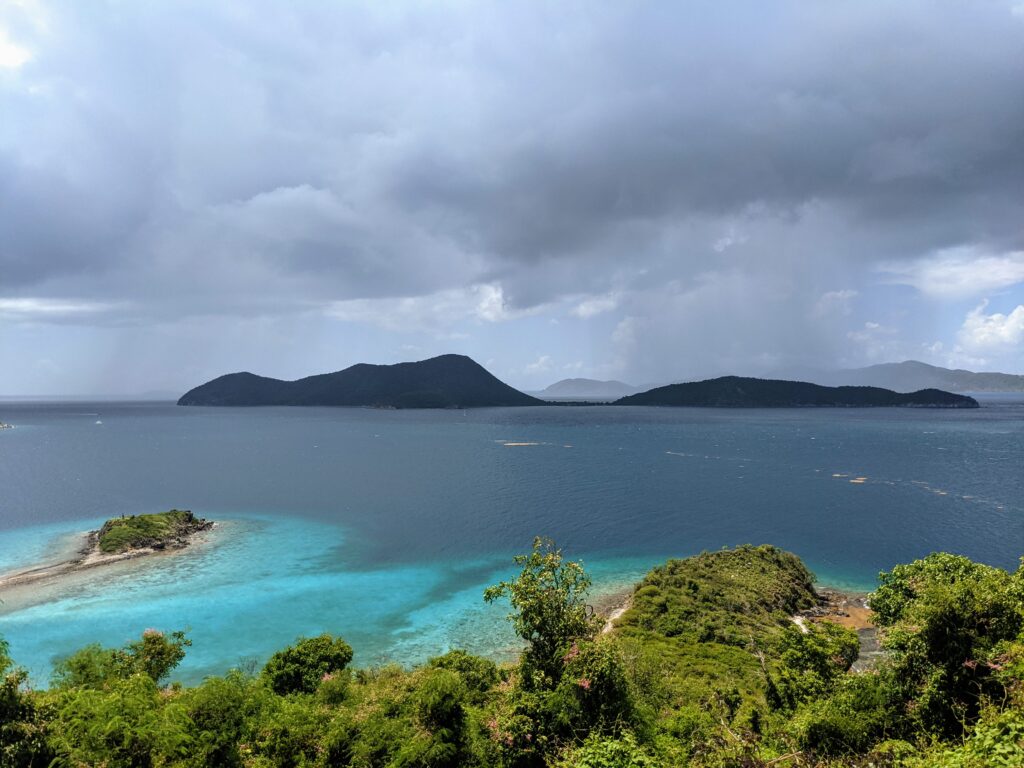
I finished up my two weeks on St. John feeling thankful to have been involved in another round of critically important reef monitoring efforts. On top of that, I was inspired by the resiliency of the Virgin Islands National Park employees and the St. John community. The island has been through some immensely difficult challenges over the last few years, to say the least. Despite that, there’s a communal sense of perseverance that I really respected.
Thank you to OWUSS, the SRC, and everyone else who helped make my trip the Virgin Islands National Park a success. I definitely couldn’t have pulled it off without the generous help finding accommodation from Lee and Devon. Thank you both! Thomas and Jeff — it was a pleasure diving with and learning from you both. And to all of the Virgin Islands NP staff who welcomed me, thank you for being such kind and supportive hosts. I hope to return soon. Now, it’s time to leave the Caribbean for real and check out the West Coast. Next time you hear from me, I’ll be writing from Kalaupapa National Historical Park. Until next time!
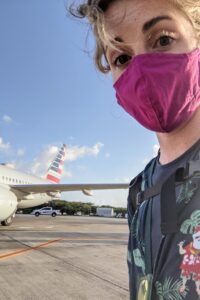
Off to the West Coast!


Finally, I found a good reading for my today’s read. Thanks. Good work.
Thank you, Alex! Glad you enjoyed it.